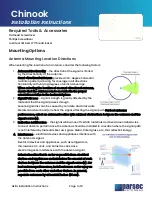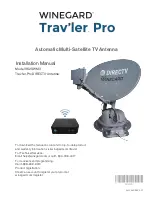
Vu Qube
V10_02
6
Installation
Mounting bracket and selecting location to run wiring
1) Select and mark both area on back of Cab to mount the bracket AND location to run
coaxial from the Vu Qube to the inside if the Cab.
·
Be sure at least 4” of Vu Qube is above the highest part of the roof so that adequate
signal can be received by the antenna. The clearance of the Vu Qube is important
because the antenna requires a direct line of site to the satellite in the southern sky to
acquire a signal.
·
The Vu Qube requires a 16” diameter of space to be mounted.
·
Make sure you allow enough space for the wiring so that that the co
axial cable does not have a sharp bend.
·
It is best to select a position on the rear of the cab free from
obstruction. Obstructions like smoke stacks, brackets, and airconditioning units may
interfere with satellite signal or prevent the satellite signal from reaching the Vu Qube.
2) Drill holes for mounting bracket with proper size depending on fasteners used.
3) Mount bracket to cab using fasteners.
4) Seal holes with a sealant compatible with cab, faring, or air shield material, depending
on where Vu Qube is mounted.
5) Drill hole to pass the harnesses inside the vehicle.
NOTE: If you are unable to install the Vu Qube 4” above the cab due to height restriction,
install with the maximum available clearance. With less of the Vu Qube top cover above the
Cab, there may be difficultly acquiring satellite signal in the Northeastern US (Maine, New
Hampshire, Vermont and Massachusetts).
NOTE: Instructions for mounting the Vu Qube is illustrated using Mounting Bracket Kit part
number 31100. This Mounting Bracket Kit and others were designed specifically to mount
the Vu Qube to the back of a truck cab. Please contact Wallace Technologies, LLC (866
8022228) regarding other bracket options.
Note: The installer is responsible for determining the most appropriate fastener to secure
the bracket to the cab. Depending on the Cab material, fasteners such as lag screws, well
nuts, sheet metal screws, toggle bolts and T anchors may be used, and should always be
used in combination with compatible sealant to environmentally seal the holes after
installation.



























